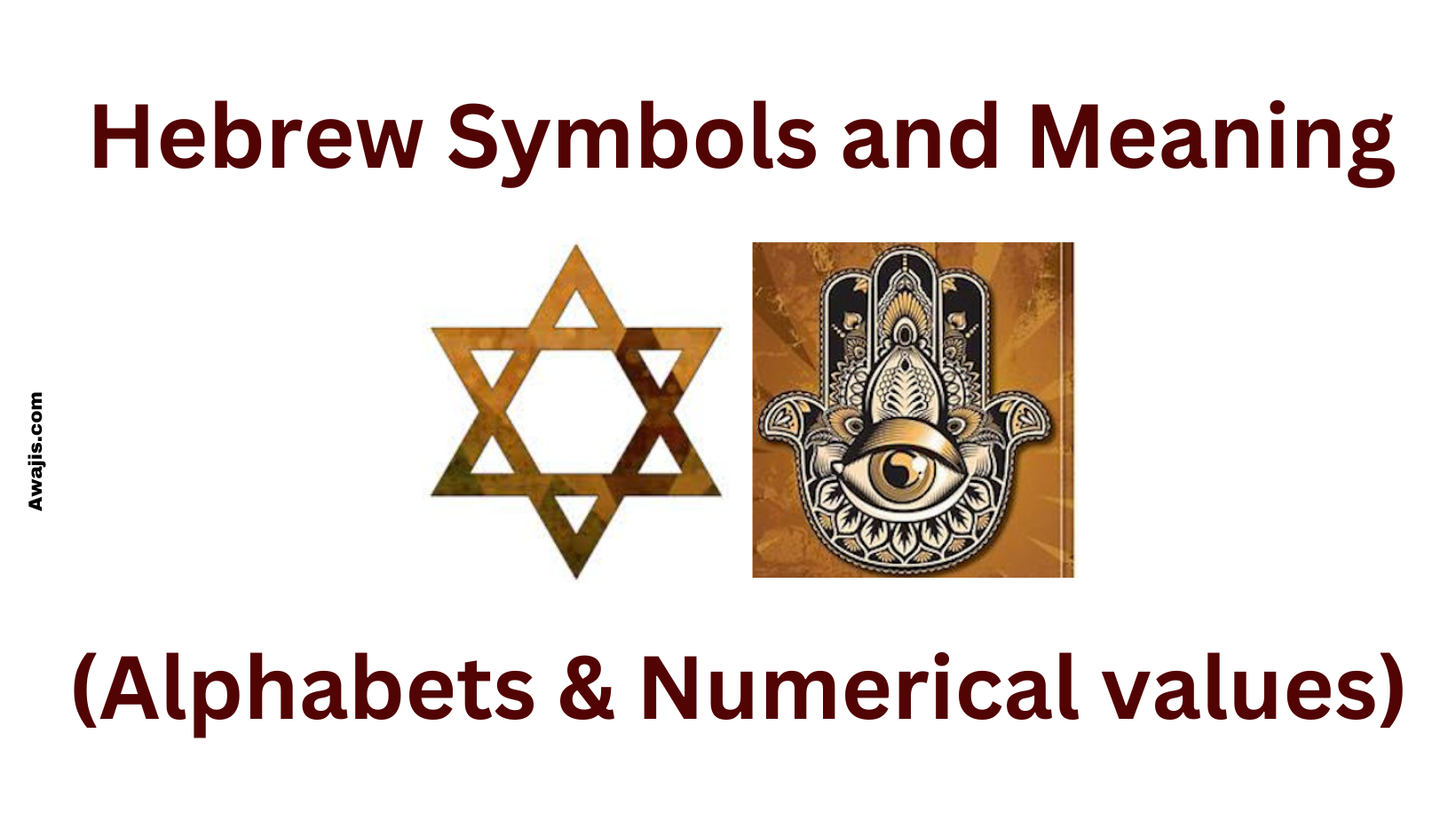Hebrew Symbols and Meaning (Alphabets & Numerical Values)
Hebrew Symbols and Meaning: Have you seen any Hebrew symbols and wondered what they mean? This article got you covered! It will interest you to know that there are many Hebrew symbols, many of which come from historical practices and beliefs. Hebrew symbols, meanings, numerical values, and other details will all be covered in this article. Continue reading!
Hebrew Symbols and Meaning
Hebrew is the official language of the people of Israel and the Jewish people; it is both spoken and written, which makes it unique. It also has a unique set of symbols, characters and numerical values; below are the symbols:
1. Star of David
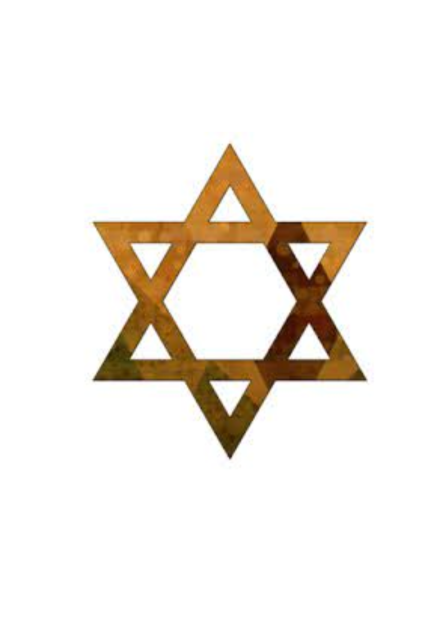 The Star of David is one of the most well-known Hebrew symbols. The Magen David, also known as the Shield of David or Star of David, is a symbol widely associated with Judaism. Despite its long history in Jewish art, its widespread use only began in recent centuries, around the 1600s. In earlier times, the mention of a “shield of David” referred to a symbolic shield protecting the descendants of King David, who were believed to include the Messiah.
The Star of David is one of the most well-known Hebrew symbols. The Magen David, also known as the Shield of David or Star of David, is a symbol widely associated with Judaism. Despite its long history in Jewish art, its widespread use only began in recent centuries, around the 1600s. In earlier times, the mention of a “shield of David” referred to a symbolic shield protecting the descendants of King David, who were believed to include the Messiah.
Aside from its use as a tool for marking Jewish individuals during severe anti-Semitic persecution, such as in Nazi Germany, the Star of David was not commonly used until it was adopted as the symbol of the Zionist movement in 1897 and later became the flag of Israel in 1948. While some Jewish individuals ascribe spiritual and theoretical significance to the symbol, others remain cautious due to its association with anti-Semitic violence and the controversial Zionist movement.
The Menorah
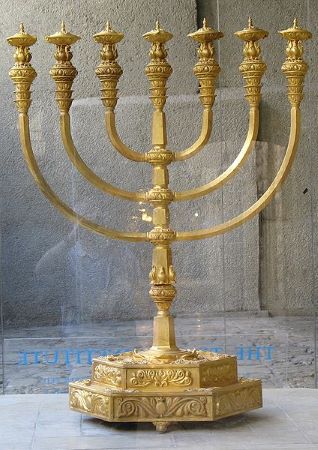
The menorah holds great significance as a traditional symbol of the Jewish people. While many associate the menorah with the Hanukkah celebration, which features a nine-branched candelabra called a Hanukkiah, the most commonly recognized menorah is a seven-branched candelabra.
The word “menorah” simply means “lamp” in Hebrew and can refer to any candelabra with candles, but in Judaism, the number seven holds a special meaning. The seven-candle menorah was historically used to light the Temple in Jerusalem, and today, each synagogue maintains its own menorah that is kept lit continuously.
The mezuzah
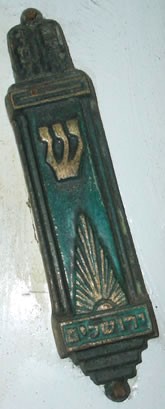
The mezuzah is another important Hebrew symbol, and is a small box that contains a scroll with verses from the Torah. It is affixed to the doorpost of Jewish homes as a reminder of the commandments and as a symbol of God’s protection over the home and its inhabitants.
Chai

The Hebrew word “chai” holds significant meaning as a Jewish symbol, representing life or living. The pronunciation of chai sounds like “hi” or “high,” unlike the popular tea beverage.
This symbol holds importance due to its simplicity and emphasis on the value of life and living in Judaism. The Jewish religion does not have a philosophy on the afterlife, as it is believed that it does not guide human action in the present life.
In Jewish mystical tradition, letters hold numerical values, and the two letters that make up the word “chai” – chet (ח) and yud (י) – represent the numbers eight and ten, adding up to eighteen. This is why gifts and donations in Judaism are commonly given in multiples of eighteen.
Torah
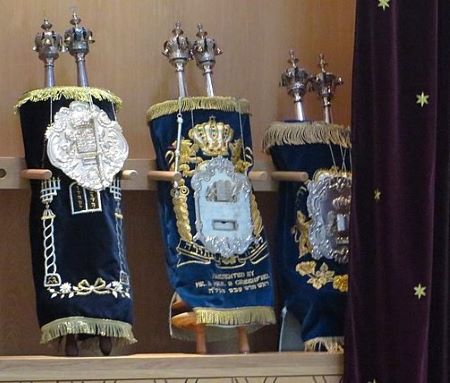
The Torah serves several purposes as a symbol. As the central text in the Jewish faith, the Torah – meaning “teaching” or “law” – is read in a specific order throughout the year, making it an integral part of the religion’s three elements: myth, symbol, and ritual.
Although the Torah can take the form of a book containing other essential Jewish texts, the iconic representation of the Torah is a scroll. A specialized scribe, called a “sofer,” meticulously handwrites each Torah scroll. During Shabbat services, worshippers uncover and unroll the Torah to the week’s relevant portion for reading. When not in use, they dress the Torah in fabric and ornate metals and store it in a cabinet known as the Ark, which stands at the front of the synagogue’s sanctuary.
The Tree of Life

The tree of life is a widely recognized symbol that holds significance in various cultural and religious contexts. In Jewish tradition, it holds multiple meanings. Primarily, the tree of life serves as a metaphor for the Torah, as evident from the line in Proverbs 3:18 that describes it as “etz chaim hee l’machazikim bah,” meaning “she is a tree of life to those who grasp her.” This implies that the Torah can guide individuals toward bettering their lives and the lives of those around them. Additionally, it alludes to the tree of knowledge of good and evil in the garden of Eden.
The tree of life also finds mention in Kabbalah, the Jewish mystical tradition. Here, it represents the Sefirot, which are divine emanations or traits that reflect God’s presence in the world. The Sefirot are arranged in a tree-like diagram, where the tree of life signifies the connection between God (the topmost part of the tree) and humanity (the roots).
Hamsa
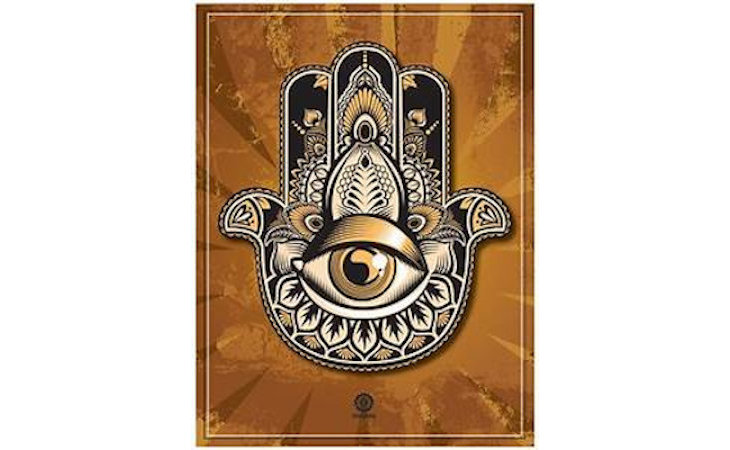
The hamsa, a hand-shaped emblem utilized by Jews and various faiths, acts as a safeguarding talisman against the “evil eye.” Certain Jewish individuals perceive the inverted hand as the hand of God. Apart from its religious connotation, the hamsa design has evolved into a fashion accessory and appears on various items, including earrings, sweatshirts, and pajamas.
In addition to these symbols, each letter of the Hebrew alphabet has its own meaning and significance. For example, the first letter, aleph, represents the oneness of God, while the second letter, bet, represents the home and family. The letters of the Hebrew alphabet are also used in Jewish numerology, where each letter is assigned a numerical value.
The Hebrew language and its symbols have played an important role in Jewish culture and tradition for thousands of years. These symbols serve as a reminder of the rich history and heritage of the Jewish people and help to connect them to their faith and community.
Hebrew Alphabets and Meanings
There are 22 letters in the Hebrew alphabet, each of which has its name and meaning. These alphabets are used to form words and sentences.
The origins of the Hebrew alphabet can be traced back to the Phoenician alphabet, which was used in the ancient world. Over time, the Hebrew alphabet, also known as the aleph-bet, developed its own unique symbolism and meaning.

Aleph (א)
Aleph represents God’s Oneness and Unity. This implies that, beneath the illusion of separation and duality, there is underlying Oneness – that nothing is separate and that the Creator is the source of all.
Bet (ב)
This letter symbolizes the home and family, as well as the idea of a house of worship.
Gimel (ג)
Gimel represents generosity and giving, as well as the idea of movement and progression.
Dalet (ד)
This letter symbolizes doors and pathways, as well as the concept of poverty and humility.
Hei (ה)
Hey represents the breath of life, as well as the feminine aspect of God.
Vav (ו)
This letter represents a hook or a connection, as well as the concept of truth and justice.
Zayin (ז)
Zayin represents the seventh day of Shabbat (Sabbath), the day of rest and spirituality, which completes the process of the six days of creation. It includes the six days and six directions of physical reality, but it also represents a distinct seventh principle or energy, the spirit, which activates the physical.
Chet (ח)
Chet or Heith stands for energy and life. And the ability of humans to rise and go beyond nature and the power of choice.
Tet (ט)
Tet is the 9 alphabet, and it stands for purity, femininity and pregnancy.
Yod (י)
The Yod symbolizes the Holy One, the Creator, as the holy name begins with Yod. Even though it’s small in size, its meaning is immense. As per the kabbalistic tradition, everything in existence emerged from a single point, which represents God’s infinite presence within the limited world.
Khaf (כ)
In Hebrew, the letter Khaf (the 11th letter of the alphabet) means “the cupped palm of the hand.” This letter resembles a cupped, open hand, ready to receive something. Interestingly, the shape of all types of containers, such as bowls, cups, and jars, are based on this same curved shape. Therefore, Khaf represents the concept of a container or form. The physical forms of the world allow for the manifestation of the spiritual essence of life.
Lamed (ל)
The Hebrew Alphabet is more than just a set of symbols. It is a powerful representation of the pursuit of knowledge. In fact, its literal translation means “learning,” and it’s also associated with “staff” or “goad.” Positioned right at the center of the aleph-beith, it embodies the essence of the heart or “Lev” in Hebrew. In Kabbalah, the pursuit of knowledge is not solely an intellectual exercise but one that engages both the heart and the soul.
The letter “Lammed,” in particular, represents the importance of spiritual learning as an integral part of the human experience. It is a reminder that the purpose of our lives is to continually seek out spiritual teachings and put them into practice with every breath we take. In essence, we are called to be lifelong learners, constantly striving to grow and develop our understanding of the world around us.
Mem (מ)
The letter Mem symbolizes the waters of wisdom, knowledge, and the Torah. It’s really cool because it represents both waters and manifestations, which means that it can help you delve deep into wisdom.
It’s said that every person has a thirst for the words of the Creator, which are the waters of life. The open Mem represents the revealed aspects of providence, while the closed Mem refers to the hidden part of the celestial rule that still guides us and all of existence.
Additionally, Mem also represents the time necessary for ripening, which reminds us of the importance of balanced emotions and humility. All in all, the letter Mem is a powerful symbol in Hebrew culture, representing both the tangible and intangible aspects of life.
Nun (נ)
The Hebrew alphabet Nuun represents faithfulness, soul and emergence. It stands for humility. The Nuun demonstrates that in order to be bound to the Creator’s will rather than our own personal egoistic ways, we must bend above and below. Nun depicts the relationship between the impermanent body and the eternal soul. It has the potential to teach us about the nature of time and space.
Samekh (ס)
Samekh symbolizes the idea of support and protection, as well as the concept of balance and stability.
Ayin (ע)
The Hebrew letter Ayin means eye and the Ayin represents the vision and bringing forth hidden lights. Ayin teaches us to look beyond ourselves and to relate to time. It is an aspect of the visionary to see beyond what is happening in front of us, to know one’s direction 5, 10, 100 years ahead, and beyond.
The Ayin’s pronunciation plays an important role; people frequently mispronounce it as a silent letter, similar to the Aleph, but its correct sound is a guttural throat sound that stimulates the thyroid gland. Ayin appears in many words associated with time (- time, – hours, – future, – past, – moment, – until, – eternity) and vision.
Peh (פ)
Pe means mouth, as well as the concept of speech and communication. Speech is considered a spiritual power in Kabbalah, which can cause good or evil depending on how it is used. In some ways, what one thinks determines how one is, and what one speaks has the potential to become.
Violent words are followed by violent actions. The quality of speech is considered to be the essence and creative existence of life. The Peh teaches us that our words are as valuable as gold and should not be spilled carelessly.
Tsade (צ)
This letter represents the idea of a hook or a fishhook, as well as the concept of righteousness and justice.
Qof (ק)
Qof symbolizes the idea of a monkey or a monkey’s tail, as well as the concept of holiness and sanctity.
Resh (ר)
This letter represents the idea of a head, as well as the concept of leadership and authority.
Shin (ש)
Shin represents the concept of fire and passion. It is often associated with the name of God and is used as an emblem in Jewish art and jewelry.
Tav (ת)
Tav is the last Hebrew letter, and it stands for truth, perfection, and completion.
Hebrew alphabet symbols and their numerical value
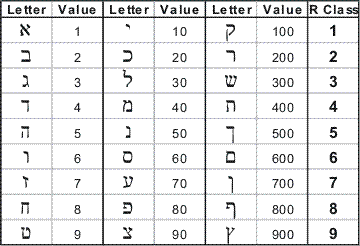 א Aleph – 1
א Aleph – 1
ב Bet – 2
ג Gimel – 3
ד Dalet – 4
ה He – 5
ו Vav – 6
ז Zayin – 7
ח Het – 8
ט Tet – 9
י Yod – 10
כ Kaf – 20
ך Final Kaf – 500
ל Lamed – 30
מ Mem – 40
ם Final Mem – 600
נ Nun – 50
ן Final Nun – 700
ס Samekh – 60
ע Ayin – 70
פ Pe – 80
ף Final Pe – 800
צ Tsadi – 90
ץ Final Tsadi – 900
ק Qof – 100
ר Resh – 200
ש Shin/Sin – 300
ת Tav – 400
It is important to note that there are different systems of gematria, and some Hebrew letters have alternative numerical values in different systems.
Conclusion
Hebrew is a very fascinating language. Each letter has its own unique meaning and symbolism, and together they form a rich tapestry of religious and cultural significance. You can improve more on your learning of the Hebrew language by using a Hebrew dictionary.
Whether you are studying Hebrew for religious purposes or simply interested in the language and its history, understanding the symbolism and meaning behind each letter can help deepen your appreciation and understanding of this fascinating language.
That’s all. Like, comment, and share!
